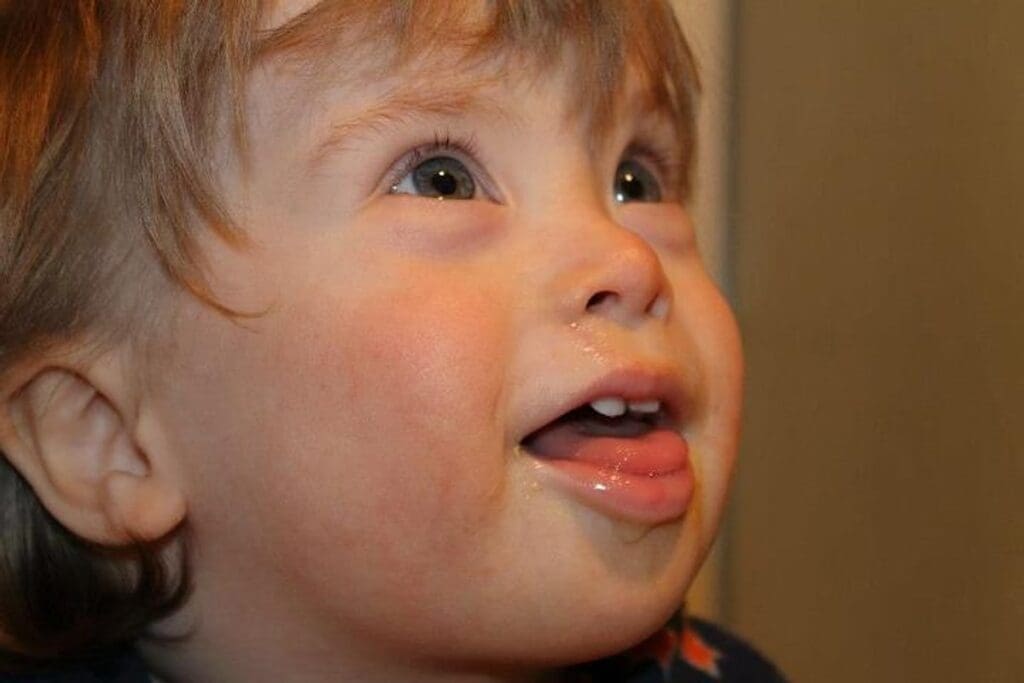Last Updated on November 24, 2025 by
Down syndrome, also known as trisomy 21, is a genetic condition. It happens when there’s an extra copy of chromosome 21. This extra genetic material leads to changes in development and physical features.

Getting a Down syndrome diagnosis can be tough for families. The Centers for Disease Control and Prevention says it’s the most common chromosomal condition in the U.S. It affects thousands of families every year.
Down syndrome is not caused by anything parents did or didn’t do. It’s a birth defect that happens during cell division. This results in an extra chromosome 21.
Down syndrome is a chromosomal condition that was once misunderstood. We now know it’s caused by an extra copy of chromosome 21, known as trisomy 21.
It happens when there’s an unusual cell division involving chromosome 21. This results in an extra chromosome 21. In the U.S., Down syndrome occurs in about 1 in every 700 live births.

The genetic cause of trisomy 21 is an error in cell division. This error leads to an extra chromosome 21 in the cells. It affects how the individual develops and looks.
Key genetic aspects include:
Down syndrome is different from other chromosomal conditions like trisomy 13 and trisomy 18. These conditions also have extra chromosomes but involve different chromosomes and symptoms.
For example, trisomy 13, or Patau syndrome, causes severe intellectual disability and physical issues. It often leads to a shorter life compared to Down syndrome.
Down syndrome is classified as a congenital condition because it’s present at birth. The term “mongoloid” is now seen as outdated and wrong.
This classification shows the need for early help and support. It’s key to the best outcomes for those with Down syndrome.
Knowing the genetic and medical facts about Down syndrome is vital for proper care and support.
Down syndrome is a common chromosomal defect found worldwide. It affects people of all ages and backgrounds. Knowing how common it is helps healthcare systems prepare better.
The number of people with Down syndrome has been growing. In the United States, the numbers have gone up. We’ll look at the latest statistics to understand this trend.
In the U.S., more people are being born with Down syndrome. The numbers went from 13.7 to 15.7 per 10,000 live births between 1999–2001 and 2010–2014. This shows we need more support for those with Down syndrome.

Maternal age is a big factor in Down syndrome risk. The risk goes up with age, from less than 0.1% at 20 to about 3% at 45. This is key to understanding Down syndrome trends.
“The risk of having a child with Down syndrome increases with the mother’s age,” research shows. This is why prenatal tests are important, mainly for older moms.
Down syndrome patterns vary by population. Knowing these helps tailor healthcare and support for different groups.
Watching Down syndrome trends shows we need a wide approach. This includes medical, educational, and social services. It’s important for people with Down syndrome to have fulfilling lives.
People with Down syndrome share certain common traits that affect their physical and mental growth. It’s key to understand these traits to offer the right support and care.
Those with Down syndrome often have unique physical traits. These can include a flat face, small head, short neck, and a tongue that sticks out. Their eyes may also slant upwards, and they might have poor muscle tone. These traits can differ greatly from person to person.
Down syndrome is linked to intellectual disability, which can vary from mild to moderate. People with Down syndrome may face developmental delays. They might need extra help in school and personal growth.
It’s important to remember that each person with Down syndrome is unique. While some may need a lot of support, others can live independently with the right care and adjustments.
Those with Down syndrome are more likely to face health issues. These can include:
Regular health check-ups and a proactive healthcare approach can greatly enhance the life quality of those with Down syndrome.
Expectant parents need to know about diagnosing Down syndrome. It happens during pregnancy or after birth. It’s important to understand the different ways to detect it.
Prenatal screening tests look for pregnancies at risk for Down syndrome. They’re not definitive but give a risk level. Non-invasive prenatal testing (NIPT) checks the mother’s blood for cell-free DNA. It screens for chromosomal issues, like Down syndrome.
Other tests include:
For high-risk pregnancies, diagnostic tests give a clear diagnosis. Amniocentesis and chorionic villus sampling (CVS) are common.
Amniocentesis takes a sample of amniotic fluid to check for chromosomal issues. CVS removes a small piece of the placenta for genetic testing.
“Diagnostic testing is key for families to prepare for a child with Down syndrome. It starts early intervention and support.”
After birth, a Down syndrome diagnosis is confirmed through physical exam and genetic tests. Usually, a karyotype test is used. It checks the baby’s chromosomes for an extra chromosome 21.
Early postnatal diagnosis is vital for starting the right care and support for the child.
Thanks to better healthcare, people with Down syndrome are living longer. This shows how far we’ve come in medical care and support for them.
Long ago, people with Down syndrome didn’t live as long as they do now. Back then, many didn’t make it past childhood or early adulthood. But, thanks to new medical tech and better care, things have changed a lot.
Now, people with Down syndrome can live up to 60 years in countries with good healthcare. This is a big jump from before. Studies show kids born today with Down syndrome might live longer than their parents did.
What’s helping them live longer includes:
Even though they’re living longer, the quality of life for those with Down syndrome matters too. Things like healthcare, education, social inclusion, and family support play big roles. It’s key to make sure they get all the care and support they need.
We know that long-term support and care from many experts are vital for those with Down syndrome. By giving them access to various services and support, we can help them live happy, fulfilling lives.
For individuals with Down syndrome, a strong support system is key to success. At LIV Hospital, we focus on providing care that meets their unique needs. This approach helps them thrive.
Early intervention is vital for kids with Down syndrome. It includes physical, occupational, and speech therapy. These programs help kids reach their full abilities.
We start these programs early to get the best results. Our team works with families to create plans that fit each child’s needs.
Educational support helps kids with Down syndrome succeed in school. It includes special plans and accommodations. This ensures they have a fair chance to learn.
Our educational support is flexible. We adapt to meet our students’ changing needs. We work with teachers and families to create a supportive learning space.
People with Down syndrome need ongoing healthcare. Our strategies include regular check-ups and managing chronic conditions. This ensures they receive the care they need.
At LIV Hospital, we’re dedicated to quality healthcare for those with Down syndrome. Our team works together to create effective care plans.
Family and community support is vital for individuals with Down syndrome. We offer counseling, support groups, and educational materials. These resources help families face challenges and seize opportunities.
With these resources, families can create a supportive environment. We aim to provide the tools and guidance families need to thrive.
Down syndrome is a complex condition that needs a supportive approach. At LIV Hospital, we offer top-notch healthcare and support for international patients.
Many people with Down syndrome live happy, healthy lives. Understanding Down syndrome and early interventions can improve their quality of life. We aim to provide advanced treatments and personalized support for those affected.
By understanding Down syndrome’s genetic basis and needs, we can move beyond the label of “birth defect.” Our goal is to empower individuals with Down syndrome to reach their full potential and lead fulfilling lives.
Down syndrome is a genetic condition. It happens when there’s an extra copy of chromosome 21. This extra genetic material leads to developmental changes and physical features.
People with Down syndrome often have certain traits. These include physical features, a range of intellectual abilities, and health issues. Each person is different.
Down syndrome can be found before or after birth. There are tests during pregnancy and after birth to confirm it.
Older mothers are more likely to have a child with Down syndrome. Women over 35 face a higher risk.
People with Down syndrome may face health issues. These include heart problems, breathing issues, and vision and hearing problems.
Mosaic Down syndrome is rare. It happens when only some cells have an extra chromosome 21. This can lead to a milder condition.
Thanks to better healthcare, people with Down syndrome live longer. Now, many live into their 50s and 60s.
There are many support systems. These include early intervention, education, healthcare, and family and community help. They help individuals with Down syndrome thrive.
Yes, Down syndrome is a spectrum disorder. The severity can vary greatly among individuals.
Down syndrome is caused by an extra chromosome 21. Other conditions, like trisomy 13, have different causes and effects.
DNA is key in Down syndrome. The extra chromosome 21 affects development and traits in individuals with Down syndrome.
National Library of Medicine. (2016). Down syndrome: Current status, challenges and future perspectives. Journal of Biomedical Science, 23(1), Article 58. https://pmc.ncbi.nlm.nih.gov/articles/PMC5125364/
Subscribe to our e-newsletter to stay informed about the latest innovations in the world of health and exclusive offers!